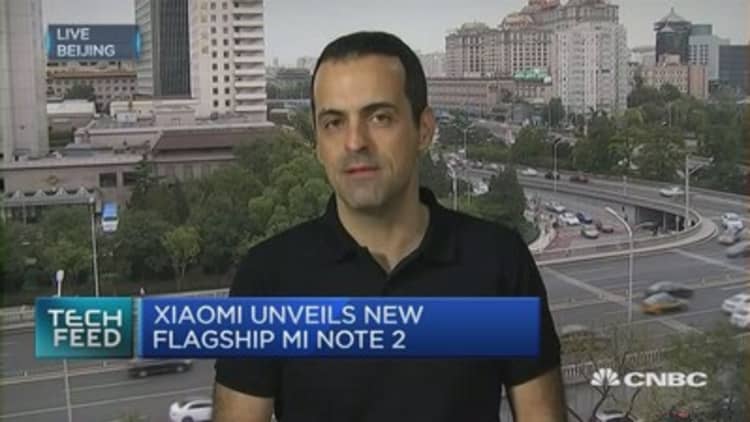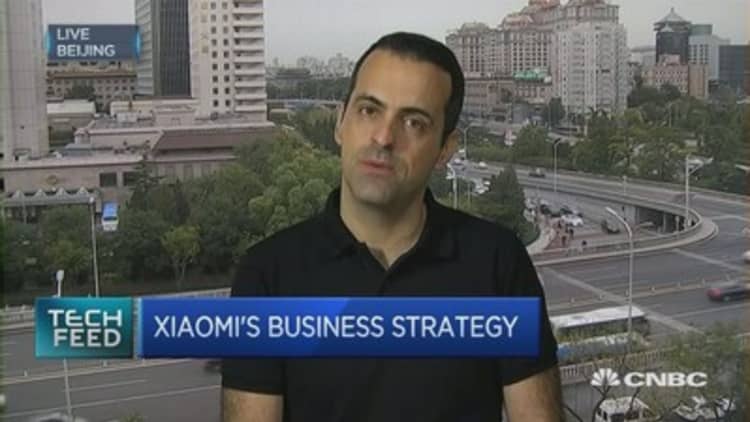


The untimely demise of Samsung's Galaxy Note 7 has opened up a chunk of the phablet market for the taking, and Chinese smartphone maker Xiaomi is the latest company to throw its name into the hat.
Xiaomi, on Tuesday, introduced two new phablets - handsets with a screen size generally ranging between 5 and 6 inches - in China: the flagship Mi Note 2, the successor to its Mi Note handset, and the new Mi MIX, with a 91.3 percent screen-to-body ratio, which was jointly developed with famed French designer Philippe Starck.
This means, aside from the margins, the screen on the Mi MIX takes up most of the phone's width and height. Xiaomi also did away with physical earpiece speaker – a crucial component in all handsets - on the device. Instead, it uses piezoelectric ceramic acoustic technology that makes it possible to listen to calls without needing the earpiece speaker.
"What we announced yesterday, in some ways, caught the world by surprise a bit," Xiaomi's global vice president, Hugo Barra, told CNBC's "Squawk Box" on Wednesday. "It's a level of innovation I think people haven't normally been expecting to come out of Asia."
Research from International Data Corporation (IDC) showed the global smartphone market is currently dominated by leaders Samsung and Apple, and Chinese rivals Huawei, OPPO and vivo, with customers demonstrating growing preference for phablets.
Earlier this year, Xiaomi was knocked out of the top five places among smartphone vendors by shipment volume and the handset maker has struggled to get back in ever since.
IDC said in March that in 2015, 20 percent of smartphones shipped were phablets and by 2020, that number was expected to rise to 32 percent.
Phablets also tend to fall in the premium category of devices - meaning they are priced much higher than the average smartphones.
Uphill task for Xiaomi
Analysts told CNBC it would be an uphill task for Xiaomi to make a meaningful dent in the phablet market segment and pick up on the Note 7 slack.
The opportunities for Xiaomi would be limited because of the lack of widespread reach in places like India and China, which are two of the largest growing smartphone markets in the world, according to Neil Shah, a research director at Counterpoint Research.
"Xiaomi has lost considerable marketshare in the premium segment and more than 80 percent [of Xiaomi's] volume comes from under $200 priced segments," he said by email.
Competition from other vendors was also a factor. Shah said in markets where Samsung's dominance is weakening, such as China, the likes of Huawei should be able to pick up the slack.
IDC senior analyst Xiaohan Tay told CNBC on Tuesday it was likely that Apple would fill up majority of the gap left behind by the Note 7. This is likely since the new iPhone 7 Plus was priced similarly and offered similar specifications.
Tracy Tsai, a research VP with Gartner's Personal Technologies team, told CNBC while Apple would be considered the strongest competitor to Samsung, the notable differences between the iOS and Android platforms could mean some users were switching to other Android vendors.
For the most part, she said in an email, users would likely stick to other Samsung handsets. "Galaxy Note series users tend to be long term Note users who prefer the design, camera, relevant applications for the [Note 7's] digital stylus ... and most importantly those users are more Samsung loyal customers."
Shah added the likes of Huawei, Google, LG in South Korea and Sony in Japan were also set to benefit.
Curved edges, quality control
That said, Xiaomi appeared to have packed quite a lot into the devices it unveiled on Tuesday.
The Mi Note 2 uses flexible OLED display and has 3D curved glass panels on the front. It has a 5.7-inch full-HD display screen with a high contrast ratio, enabling sharper images and videos.
Its main camera uses the Sony IMX318 sensor for high-res images and can support 4K video recording with electronic image stabilization.
The Mi Note 2 is powered by the Snapdragon 821 processor and has up to 6GB memory and 128GB storage.
"[The] Mi Note 2 is quite impressive from specifications perspective on paper, compared to other flagship phablets," Shah said.
Mi Note 2 also comes with a 4,070mAH battery, which should theoretically be able to keep the phone powered all day. The Samsung's Note 7, on the other hand, used a 3,500mAh battery.
Barra told CNBC Xiaomi employed "very, very high quality control standards" to ensure its battery did not cause similar troubles as the Note 7's batteries reportedly did.
"We pay close attention to quality control. We test these components very, very thoroughly."


